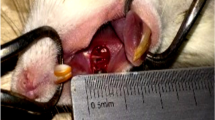Abstract
The objective of this study was to investigate the effects of mangrove tea on salivary bacterial flora in DMBA induced hamster buccal pouch carcinoma. Tea from mangrove plant Ceriops decandra was administered against DMBA induced buccal pouch carcinoma in hamster rats. The chemical constitutions and quality of mangrove tea is similar with the commercial tea Camellia sinensis. The Hamster rats were painted thrice a week with DMBA in their right buccal pouch, and also administrated orally with 1.25% of Ceriops tea extract, on alternate days of the DMBA treatment. Appropriate control animals were maintained. After 14 weeks of treatment, bacterial species in saliva were enumerated, tumor incidences were analyzed using histopathological section and tumor volume in the animals was quantified using water-displaced method. The decreased counts of beneficial bacteria and increased counts of harmful bacteria were associated with increased volume of tumors. The present study concluded that the tea extract from C. decandra prevents the oral cancer incidences and maintain the good health conditions of the animals.




Similar content being viewed by others
References
Sugerman PB, Joseph BK, Savage NW (1995) The role of oncogenes, tumor suppressor genes and growth factors in oral squamous cell carcinoma: a case of apoptosis versus proliferation. Oral Dis 1:172–188
Rodrigues VC, Moss SM, Tuomainen H (1998) Oral cancer in the UK: to screen or not to screen. Oral Oncol 34:454–465
Chen AY, Myers JN (2001) Cancer of the oral cavity. Dis Mon 47:274–361
Brown AE, Langdon JD (1995) Management of oral cancer. Ann R Coll Surg Engl 77:404–408
Zakrzewska JM (1999) Fortnightly review: oral cancer. BMJ 318:1051–1054
Nagy KN, Sondoki I, Szoke I, Nagy E, Newman HN (1998) The microflora associated with human oral carcinomas. Oral Oncol 34:304–308
Mager DL, Haffajee AD, Devlin PM, Norris CM, Posner MR, Goodson JM (2005) The salivary microbiota as a diagnostic indicator of oral cancer: A descriptive, non-randomized study of cancer-free and oral squamous cell carcinoma subjects. J Transl Med 3:1–8
Friedman M, Mackey BE, Kim HJ (2007) Structure-activity relationships of tea compounds against human cancer cells. J Agric Food Chem 55:243–253
Bandaranayake WM (1998) Traditional medicinal uses of mangroves. Mang Salt Mars 2:133–148
Bandaranayake WM (2002) Bioactivities: bioactive compounds and chemical constituents of mangrove plants. Wetl Ecol Manag 10:421–452
Padmakumar K (1988) Bioactive substances from marine algae and mangroves. Ph.D Thesis, Annamalai University, Parangipettai p. 81
Sakagami H, Kashimita M, Toguchi M, Satoh K, Odanaka Y, Ida Y, Premanathan M, Arakaki R, Kathiresan K, Nakashma H, Komatsu N, Fujimarki M, Yoshihara M (1998) Radical modulation activity of lignins from a mangrove plant, Ceriops decandra (Griff.). Ding Hou In vivo 12:327–332
Kathiresan K, Veera Ravi A (1990) Seasonal changes in tannin content of mangrove leaves. Ind For 116:390–392
Kathiresan K (1995) Studies on tea from mangrove leaves. Environ Ecol 13:321–323
Lurie AD, Nintzal BB, Rippey RM (1977) Vascular volume and perfusion in hamster cheek pouches. Can Res 37:3484–3489
Shklar G (1972) Experimental oral pathology in the Syrian hamster. Prog Exp Tumor Res 16:518–538
Holt JG, Krieg RN, Sneath PHA, Staley JT, Williams ST (1983) Bergey’s Manual System. Bacteriology 4:440
Oliver JD (1982) Instruments and methods: taxonomic scheme for the identification of marine bacteria. Deep Sea Res 29:795–798
Zeldow BJ (1961) Studies on the antibacterial action of human saliva: II observations on the mode of action of a lactobacillus bacteriocin. J Dent Res 40:446–453
Hirayama K, Rafter J (2000) The role of probiotic bacteria in cancer prevention. Micro Infec 2:681–686
Singh J, Rivenson A, Tomita M, Shimamura S, Ishibashi N, Reddy BS (1997) Bifidobacterium longum, a lactic acid-producing intestinal bacterium inhibits colon cancer and modulates the intermediate biomarkers of colon carcinogenesis. Carcinogenesis 4:833–841
Bodana AR, Rao DR (1990) Antimutagenic activity of milk fermented by Streptococcus thermophilus and Lactobacillus bulgaricus. J Dairy Sci 73:3379
Mitsuoka T (1990) Bifidobacteria and their role in human health. J Ind Microbiol 6:263–267
Spijkervet FKL, Saene JJ, Saene HK, Panders AK, Vermey A, Feilder V (1990) Chlorohexidine inactivation by saliva. Oral Surg Oral Med Oral Pathol 69:437–444
Keyes PH (1960) The infectious and transmissible nature of experimental dental caries. Findings and implications. Arch Oral Biol 1:304–320
DeVugst L, Vandamme EJ (1994) Bacteriocins of lactic acid bacteria. Microbiol Genet Appl London 75:140174–140179
Kathiresan K, Thiruneelakandan G (2008) Prospects of lactic acid bacteria of marine origin. Ind J Biotech 7:170–177
Wollowski I, Rechkemmer G, Pool-Zobel BL (2001) Protective role of probiotics and prebiotics in colon cancer. Am J Clin Nutri 73:451–455
Goldin BR, Gorbach SL (1992) Probiotics for humans. In: Fuller R (ed) Probiotics. Champ Hall, London, pp 355–376
Devine DA, Marsh PD (2009) Prospects for the development of probiotics and prebiotics for oral applications. J Oral Microbiol 1:1–11
Acknowledgments
The authors are thankful to the authorities of Annamalai University for having provided with facilities.
Author information
Authors and Affiliations
Corresponding author
Rights and permissions
About this article
Cite this article
Sithranga Boopathy, N., Kandasamy, K., Subramanian, M. et al. Effect of Mangrove Tea Extract from Ceriops decandra (Griff.) Ding Hou. on Salivary Bacterial Flora of DMBA Induced Hamster Buccal Pouch Carcinoma. Indian J Microbiol 51, 338–344 (2011). https://doi.org/10.1007/s12088-011-0096-3
Received:
Accepted:
Published:
Issue Date:
DOI: https://doi.org/10.1007/s12088-011-0096-3




